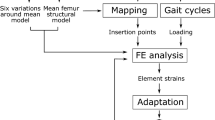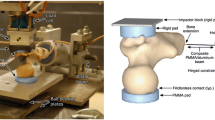Abstract
Although it is known that long cortical bone structurally alter their area moment of inertia with age related bone loss maintaining their bending strength, the incidence of fragility fractures associated with cortical thinning still prevails. We hypothesize that cortical thinning with aging increases the local buckling susceptibility under abnormal or eccentric loads, and initiates fracture. The paper presents a series of 3D geometrical model derived from CT scans of a human femoral neck used to simulate age-related bone loss. The purpose of the model is to predict the susceptibility of local buckling at the femoral neck in falls by elderly folks. Geometric three-dimensional models of femoral neck cortices were developed from 7 human cadaver femurs (4 female, 3 male, 52–68 years). Three age related femoral neck models were simulated by either reducing (young age-related model) or increasing (old age-related model) the outer cortical surfaces in the radial-direction, by 1-mm. The control model was the middle-age related model. The inner cortex diameter was also adjusted to equilibrate the compressive stresses, based on the load-profile of a single-legged stance. Based on the old age related model, two additional “fragile” models were simulated by reducing the compressive load profile by 10 and 20% changing the inner cortex diameter, respectively. Using these models for each specimen, the consequence of a fall on the greater trochanter was evaluated. The Finite Strip Method (FSM) was used to investigate the association between local buckling at the femoral neck and the load to failure. Under constant loading, buckling progressively reduced the load to failure with aging, as seen in 2/7 of the middle age (by 9–15%) and 5/7 of the old age (by 7–32%) related models. In the fragile models, a 51% reduction in the load to failure was noted. Structural adaptation to age-related bone loss might preserves the bending strength under physiologic loads, but cortical thinning effects the buckling ratio reaching a critical threshold that would make the bone susceptible to local buckling at the femoral neck increasing the risk of fracture in a fall.





Similar content being viewed by others
References
Beck, T., A. Looker, F. Mourtada, M. Dapthary, and C. B. Ruff. Age trends in femur stresses from a simulated fall on the hip among men and women: evidence of homeostatic adaptation underlying the decline in hip BMD. J. Bone Miner. Res. 21:1443–1456, 2006.
Beck, T. J., A. C. Looker, C. B. Ruff, H. Sievanen, and H. W. Wahner. Structural trends in the aging femoral neck and proximal shaft: analysis of the Third National Health and Nutrition Examination Survey dual-energy X-ray absorptiometry data. J. Bone Miner. Res. 15(12):2297–2304, 2000.
Beck, T. J., T. L. Oreskovic, K. L. Stone, C. B. Ruff, K. Ensrud, M. C. Nevitt, H. K. Genant, and S. R. Cummings. Structural adaptation to changing skeletal load in the progression toward hip fragility: the study of osteoporotic fractures. J. Bone Miner. Res. 16(6):1108–1119, 2001.
Bell, K. L., N. Loveridge, J. Power, N. Garrahan, M. Stanton, M. Lunt, B. F. Meggitt, and J. Reeve. Structure of the femoral neck in hip fracture: cortical bone loss in the inferoantererior to superoposterior axis. J. Bone Miner. Res. 14:111–119, 1999.
Bell, K. L., N. Loveridge, J. Power, N. Rushton, and J. Reeve. Intracapsular hip fracture: increased cortical remodeling in the thinned and porous anterior region of the femoral neck. Osteoporos. Int. 10:248–257, 1999.
Cezayirlioglu, H., E. Bahniuk, D. Davy, and K. Heiple. Anisotropic yield behavior of bone under combined axial force and torque. J. Biomech. 18:61–69, 1985.
Cheung, Y. K., and L. G. Tham. The Finite Strip Method. New York: CRC Press, 1998.
Cowin, S. C. The mechanical properties of cortical bone tissue. In: Bone Mechanics, edited by S. C. Cowin. Boca Raton, Florida: CRC Press, 1989, pp. 97–127.
Crabtree, N., N. Loveridge, M. Parker, N. Rushton, J. Power, K. L. Bell, T. J. Beck, and J. Reeve. Intracapsular hip fracture and the region-specific loss of cortical bone: analysis by peripheral quantitative computed tomography. J. Bone Miner. Res. 16(7):1318–1328, 2001.
Eckstein, F., C. Wunderer, H. Boehm, V. Kuhn, M. Priemel, T. M. Link, and E. M. Lochmuller. Reproducibility and side differences of mechanical tests for determining the structural strength of the proximal femur. J. Bone Miner. Res. 19:379–385, 2004.
Ford, C. M., T. M. Keaveny, and W. C. Hayes. The effect of impact direction on the structural capacity of the proximal femur during falls. J. Bone Miner. Res. 11(3):377–383, 1996.
Frankel, V., and A. Burstein. Orthopaedic Biomechanics. Philadelphia: Lea and Febiger, 1970.
Frost, H. M. From Wolff’s law to the mechanostat: a new “face” of physiology. J. Orthop. Sci. 3(5):282–286, 1998.
Gibson, L. J., and M. F. Ashby Cellular. Solids: Structure and Properties. Cambridge Press, 1999.
Gluer, C. C., S. R. Cummings, A. Pressman, J. Li, K. Gluer, K. G. Faulkner, S. Grampp, and H. K. Genant. Prediction of hip fractures from pelvic radiographs: the study of osteoporotic fractures. The Study of Osteoporotic Fractures Research Group. J. Bone Miner. Res. 9(5):671–677, 1994.
Homminga, J., B. R. McCreadie, T. E. Ciarelli, H. Weinans, S. A. Goldstein, and R. Huiskes. Cancellous bone mechanical properties from normals and patients with hip fractures differ on the structure level, not on the bone hard tissue level. Bone 30(5):759–764, 2002.
Kaptoge, S., N. Dalzell, R. W. Jakes, N. Wareham, N. E. Day, K. T. Khaw, T. J. Beck, N. Loveridge, and J. Reeve. Hip section modulus, a measure of bending resistance, is more strongly related to reported physical activity than BMD. Osteoporos. Int. 14(11):941–949, 2003.
Kaptoge, S., N. Dalzell, N. Loveridge, T. J. Beck, K. T. Khaw, and J. Reeve. Effects of gender, anthropometric variables, and aging on the evolution of hip strength in men and women aged over 65. Bone 32(5):561–570, 2003.
Keaveny, T. M., E. F. Wachtel, C. M. Ford, and W. C. Hayes. Differences between the tensile and compressive strengths of bovine tibial trabecular bone depend on modulus. J. Biomech. 27(9):1137–1146, 1994.
Lovejoy, C. O. The evolution of human walking. Sci. Am. 259(5):118–125, 1988.
Mayhew, P., C. Thomas, J. Clement, N. Loveridge, T. W. B. Beck, C. Burgoyne, and J. Reeve. Relation between age, femoral neck cortical stability, and hip fracture risk. Lancet 366:129–135, 2005.
McLeish, R. D., and J. Charnley. Abduction forces in the one-legged stance. J. Biomech. 3(2):191–209, 1970.
McNeel, R. Rhinoceros. Seattle: McNeel North America, 1998.
Park, H., K. J. Kim, T. Komatsu, S. K. Park, and Y. Mutoh. Effect of combined exercise training on bone, body balance, and gait ability: a randomized controlled study in community-dwelling elderly women. J. Bone Miner. Metab. 26(3):254–259, 2008.
Parkkari, J., P. Kannus, M. Palvanen, A. Natri, J. Vainio, H. Aho, I. Vuori, and M. Jarvinen. Majority of hip fractures occur as a result of a fall and impact on the greater trochanter of the femur: a prospective controlled hip fracture study with 206 consecutive patients. Calcif. Tissue Int. 65(3):183–187, 1999.
Riggs, B., L. Melton, R. Robb, J. Camp, E. Atkinson, A. Oberg, P. Rouleau, C. McCollough, S. Khosla, and M. L. Bouxsein. Population-based analysis of the relationship of whole bone strength indices and fall-related loads to age- and sex-specific patterns of hip and wrist fractures. J. Bone Miner. Res. 21:315–323, 2006.
Rivadeneira, F., M. C. Zillikens, C. E. De Laet, A. Hofman, A. G. Uitterlinden, T. J. Beck, and H. A. Pols. Femoral neck BMD is a strong predictor of hip fracture susceptibility in elderly men and women because it detects cortical bone instability: the Rotterdam Study. J. Bone Miner. Res. 22(11):1781–1790, 2007.
Schafer, B. W. Local, distortional, and Euler buckling in thin-walled columns. J. Struct. Eng. 128:289–299, 2002.
Schafer, B. W. CUFSM—Elastic Buckling Prediction, Baltimore, 2004.
Schafer, B. W., and T. Pekoz. Laterally braced cold-formed steel flexural members with edge stiffened flanges. J. Struct. Eng. 125:118–127, 1999.
Silva, M., and L. J. Gibson. Modeling the mechanical behavior of vertebral trabecular bone: effects of age-related changes in microstructure. Bone 21(2):191–199, 1997.
Thurner, P., P. Wyss, R. Voide, M. Stauber, M. Stampanoni, U. Sennhauser, and R. Muller. Time-lapsed investigation of three-dimensional failure and damage accumulation in trabecular bone using synchrotron light. Bone 39(2):289–299, 2006.
Timoshenko, S., and J. M. Gere. Theory of Elastic Stability. New York: McGraw-Hill, 1961.
van Rietbergen, B., R. Huiskes, F. Eckstein, and P. Ruegsegger. Trabecular bone tissue strains in the healthy and osteoporotic human femur. J. Bone Miner. Res. 18(10):1781–1788, 2003.
Verhulp, E., B. Van Rietbergen, and R. Huiskes. Comparison of micro-level and continuum-level voxel models of the proximal femur. J. Biomech. 39(16):2951–2957, 2006.
Volokh, K. Y., H. Yoshida, A. Leali, J. F. Fetto, and E. Y. S. Chao. Prediction of femoral head collapse in osteonecrosis. J. Biomech. Eng. 128(3):467–470, 2006.
von Karman, T., E. Sechler, and L. Donnel. The strength of thin plates in compression. Trans. ASME 54:53–57, 1932.
Wand, J. S., I. Hill, and J. Reeve. Coxarthorsis and femoral neck fracture. Clin. Orthop. Related Res. 278:88–94, 1990.
Wang, L., P. B. Orhii, J. Banu, and D. N. Kalu. Effects of separate and combined therapy with growth hormone and parathyroid hormone on lumbar vertebral bone in aged ovariectomized osteopenic rats. Bone 28(2):202–207, 2001.
Winter, G. Strength of thin steel compression flanges. Trans. Am. Soc. Civ. Eng. 112:527–554, 1947.
Young, W. Elastic stability formulas for stress and strain. In: Roark’s Formulas for Stress and Strain, edited by H. Crawford and S. Thomas. New York: McGraw-Hill, 1989, p. 688.
Acknowledgments
This work was supported by the Academic Research Funding (AcRF #R397-000-618-112/133) from the Ministry of Education (MoE), Singapore.
Author information
Authors and Affiliations
Corresponding author
Rights and permissions
About this article
Cite this article
Lee, T., Choi, J.B., Schafer, B.W. et al. Assessing the Susceptibility to Local Buckling at the Femoral Neck Cortex to Age-Related Bone Loss. Ann Biomed Eng 37, 1910–1920 (2009). https://doi.org/10.1007/s10439-009-9751-9
Received:
Accepted:
Published:
Issue Date:
DOI: https://doi.org/10.1007/s10439-009-9751-9




